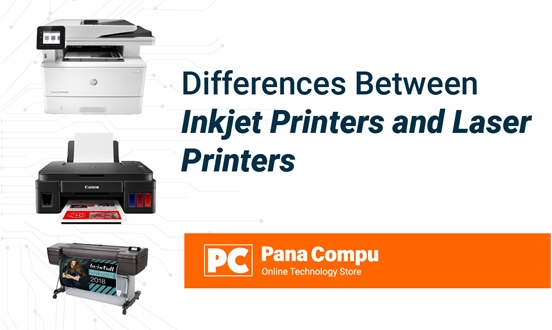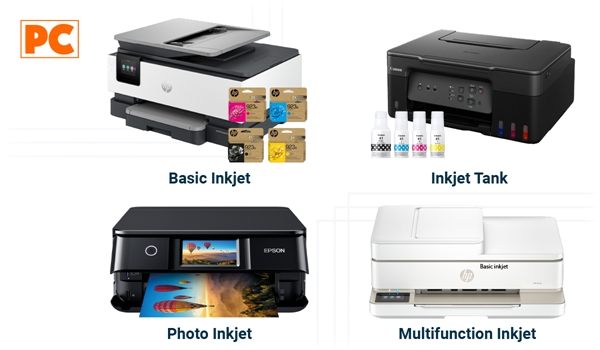Differences Between Inkjet Printers and Laser Printers
When purchasing a printer, it is possible to feel overwhelmed or lost among all the options offered on the market and it can be difficult to know which option is best for me if I need a printer for my company, my office or for my home.

It is essential to know the differences when choosing between a laser printer, an inkjet printer, and an ink printer, to help you make the best decision regarding which model best suits your needs and thus achieve the best possible quality in your work. You will learn to identify which is the best option that adapts to you, not only in terms of quality but also economically.
At Pana Compu, we have multiple models of Printers in Panama and Printers in Peru. This is what you should know before buying a printer.
Inkjet Printers
An inkjet printer (or ink printer) uses liquid ink cartridges to print images or text. These printers spray tiny droplets of ink directly onto the paper to create detailed, high-quality prints. Types of inkjet printers include:

- Basic inkjet printers: Ideal for home use or small offices, these printers handle simple documents or occasional images.
- Photo inkjet printers: Designed to print high-quality photos, they are popular with photographers and graphic designers.
- Ink tank printers: These use refillable tanks instead of traditional cartridges, which reduces costs in the long run. Brands such as Epson EcoTank or Canon MegaTank are notable examples.
- Multifunction inkjet printers: These printers print, scan, copy, and, in some cases, fax. They are convenient for users who need multiple functions in one device.
What are the main advantages and disadvantages of Inkjet Printers?
Among the advantages of inkjet printers, we have:
- Excellent print quality, especially for photos and graphics.
- Suitable for a variety of paper types, from photo paper to regular paper.
- Generally, it is more compact and economical at the time of purchase.
Among the disadvantages of inkjet printers:
- Ink may dry out if not used regularly.
- Expensive cartridges and lower yield compared to laser printer toner.
What is the cost and maintenance of an inkjet printer?
The initial price of an inkjet printer is often more affordable, making them a popular choice for home users. However, ink cartridge costs can add up quickly, especially if you print frequently.
- Cost per page: High, especially for color printing.
- Maintenance: Requires replacing cartridges more frequently.
What is the recommended print volume for inkjet printers?
Inkjet printers are perfect for users who print occasionally or in moderate quantities. If you need to print documents at home, school projects, or photos from time to time, this type of printer will suffice. However, they are not the best choice for those who print large volumes on a consistent basis.
- Recommended volume: Between 50 and 500 pages per month.
- Risk of ink drying: If you do not use your printer regularly, the ink can dry out, leading to cleaning the print heads or even replacing the cartridges, increasing costs.
- Cartridge replacement frequency: High, especially if you print a lot of color pages.
Who are inkjet printers ideal for?
- Home users who print occasionally.
- People who need high quality for photographs and graphics.
Does the Inkjet Printer Fit Your Space?
Inkjet printers are typically smaller and lighter than laser printers, making them an ideal choice for homes, small offices, or users who need flexibility in location.
- Average size: Inkjet printers have compact dimensions, with widths around 40 cm and weights between 3 and 7 kg.
- Design: Many models are designed to blend with existing home furnishings, including modern finishes and neutral color options.
- Portability: Thanks to their light weight, you can easily move them from one place to another. This is useful for those who work from home and change spaces frequently.
Additionally, some inkjet printers are specifically designed to be portable, with built-in batteries and wireless connectivity, ideal for those who need to print while traveling or in temporary locations.
Laser Printers
A laser printer uses electrophotographic technology and powdered toner to print. It works by using a laser beam that creates an electrostatic image on a drum, to which the toner adheres before being transferred to the paper. This method offers fast, high-quality prints, especially for black-and-white documents. Laser printer formats include:

- Monochrome laser printers: Designed to print in black only, these are perfect for offices with high-volume text printing needs.
- Color laser printers: These offer the ability to print in color, making them useful for visually appealing presentations or documents.
- Multifunction laser printers: These combine printing, scanning, copying, and, in some cases, faxing. They are ideal for offices or business environments.
- Compact laser printers: These are smaller versions designed for small spaces while maintaining printing speed and efficiency.
- High-capacity laser printers: Suitable for businesses with high print volumes, they have enlarged paper trays and longer-lasting toners.
What are the main advantages and disadvantages of Laser Printers?
Among the advantages of laser printers, we have:
- Significantly faster printing speed.
- More efficient for large volumes of documents.
- Lower cost per page, ideal for offices.
Among the disadvantages of laser printers:
- Less accurate in color or photographic prints.
- Larger size and higher initial price.
What is the cost and maintenance of a laser printer?
Although the initial cost of a laser printer is higher, it can be cheaper to maintain over the long term. Toners are more expensive but offer greater printing capacity.
- Cost per page: Low, especially for monochrome printing.
- Maintenance: Less frequent due to the greater durability of the toner.
What is the recommended print volume for laser printers?
Laser printers are designed to handle heavy workloads, making them the best choice for offices, small businesses, or users who print large quantities regularly. Thanks to high-capacity toners, you can print thousands of pages without having to replace consumables frequently.
- Recommended volume: 500 to 5,000 pages per month or more, depending on the model.
- Greater efficiency: Laser printer toners have significantly higher yields, reducing cost per page and maintenance frequency.
- Long-term use: They can operate smoothly for years even with intensive use.
Are Laser Printers Right for Your Space?
Laser printers tend to be larger and heavier, which can be a drawback if you have limited space or need to move it regularly. This is due to the additional components they require, such as the imaging drum, fuser, and toner.
- Average size: Basic laser printers for home use can measure between 40 and 50 cm wide, while more advanced models for offices can exceed 60 cm. They weigh between 7 and 20 kg or more, depending on their capabilities.
- Design: They tend to prioritize functionality over aesthetics, with a focus on efficiency for office environments.
- Portability: Due to their weight and size, these printers are not designed to be transported frequently. Once installed, it is best to leave them in a fixed location.
Who are laser printers ideal for?
- Offices that require fast, high-volume printing.
- Users who primarily print black and white documents.
Which has better quality, inkjet printers or laser printers?
Print quality is one of the most important factors when choosing between an inkjet printer and a laser printer. While both technologies offer good results, their performance varies depending on the type of content you want to print.
- Text: Laser printers are superior in terms of sharpness and clarity of text, making them ideal for professional documents.
- Imaging: Inkjet printers excel at printing photographs and graphics due to their ability to produce a wider range of colors and details.
How to calculate cost per impression?
Calculating the cost per print is essential to making an informed decision when purchasing a printer. This figure will help you understand how much you will spend each time you print a page, considering not only the initial price of the printer, but also the ongoing costs associated with consumables. What are the key factors in calculating the cost per print?
- Consumables price: Includes ink cartridges, toner or any other consumables needed for printing.
- Consumables yield: The yield indicates how many pages a cartridge or toner can print before running out. This is usually specified in the product specifications (for example, "up to 500 pages per cartridge").
- Additional costs: Consider other factors such as paper, maintenance, or components that may be needed in the long term, such as drums or fusers in laser printers.
- Print Type: Printing in black and white is often more economical than printing in color or with complex graphics.
The cost per print is calculated by dividing the price of the consumable by its yield:
Cost per print = Number of printable pages / Price of consumable
Example 1 for an Inkjet Printer:
- Black ink cartridge price: $20
- Cartridge yield: 200 pages.
- Cost per print = $20 / 200 pages = $0.10 (10 cents per page).
If you use color cartridges, you will need to calculate the cost for each cartridge and add them up if you use all of them in one print.
Example 2 for a Laser Printer:
- Black ink cartridge price: $80
- Cartridge yield: 2,500 pages.
- Cost per print = $80 / 2,500 pages = $0.032 (3.2 cents per page).
In this case, the cost per print is considerably lower than that of inkjet printers.
What Should You Know Before Buying a Printer?
When choosing between inkjet and laser printers, it is crucial to consider several factors that align with your specific needs. Print quality, cost per page, speed, and intended use are key aspects to evaluate. Each type of printer has its advantages and disadvantages, which can influence your purchasing decision.
If you want to delve deeper into what you need to take into account before making your choice, we invite you to read our article What Should You Know Before Buying a Printer? There you will find essential information that will help you select the right printer for your requirements.
In conclusion, what are the differences between Inkjet Printers and Laser Printers?
Choosing between a laser printer and an inkjet printer depends entirely on your printing needs and habits. If you're looking for a solution that's economical to start with, flexible and capable of producing high-quality colour prints, inkjet printers are ideal, especially for home or student use. However, you have to consider their higher running cost and frequent maintenance, such as cartridge replacement and the possibility of ink drying out if not used regularly.
On the other hand, laser printers are an excellent choice for those who print in high volumes or need fast and reliable results, especially in black and white. Although their initial cost is higher, their low cost per print and lower maintenance make them an efficient long-term investment. However, their larger size and limited quality for color or photo prints may be a drawback for some users.
Ultimately, your choice should be based on factors such as your required print quality, monthly page volume, available budget, and available space. Analyzing the cost per print and your priorities will help you determine which type of printer best suits your needs, ensuring you make a practical and cost-effective decision for the future.
Comments
All opinions are of our customers friends. Join the conversation!
No comments yet... Be the first!